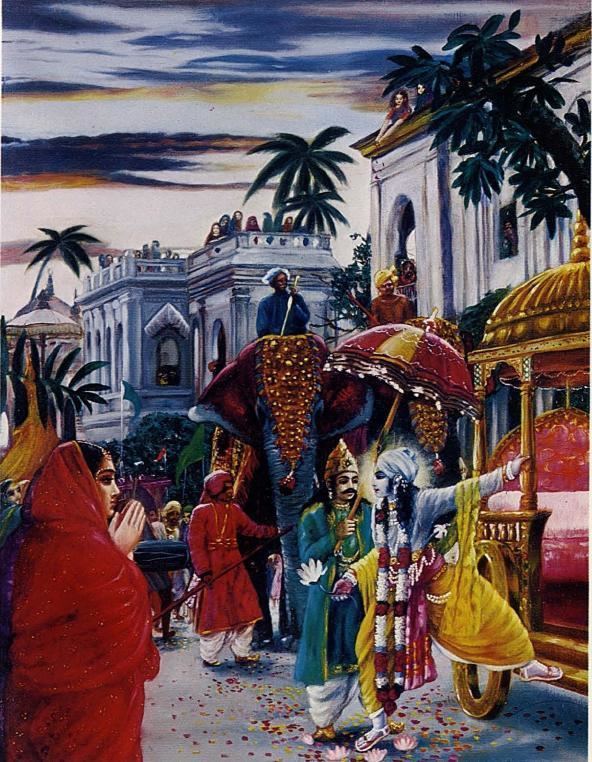 | ||
Dvaraka, also known as Dvāravatī (Sanskrit "the many-gated [city]") is a sacred city in Hinduism, Jainism and Buddhism. The name Dvārakā is said to have been given to the place by the Hindu god Krishna. Dvārakā is one of the Sapta Puri (seven sacred cities) of Hinduism.
Contents

In the Mahabharata, it was a city located in what is now Dwarka, formerly called Kushasthali, the fort of which had to be repaired by the Yadavas. In this epic, the city is described as a capital of the Anarta Kingdom. According to the Harivamsa the city was located in the region of the Sindhu Kingdom.
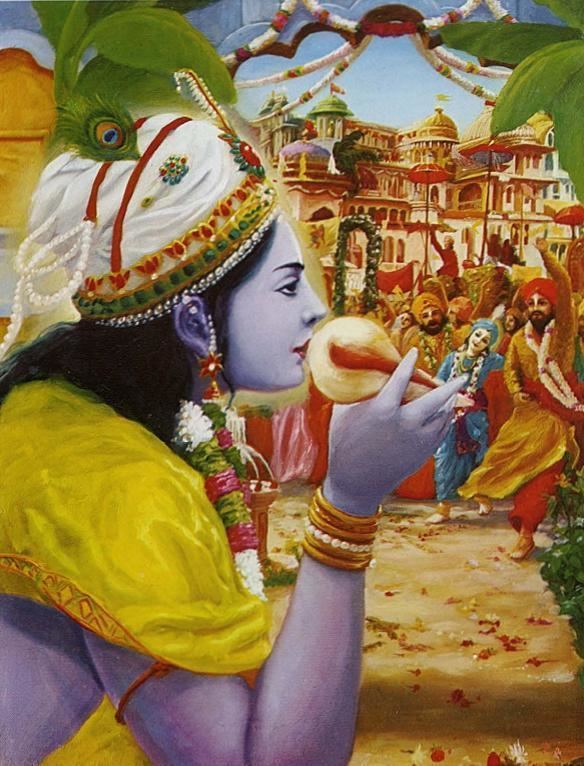
In the Gocharya ji krit "Krishnacharitmanas" out of 3 parts, two parts are Dwariki Krishna (Part-2) & Part 3.

In the Hindu epics and the Vaishnava Puranas, Dvārakā is called Dvaravati and is one of seven Tirtha (pilgrimage) sites for spiritual liberation. The other six are Mathura, Ayodhya, Kashi, Kanchipuram, Avantika (Ujjain) and Puri.
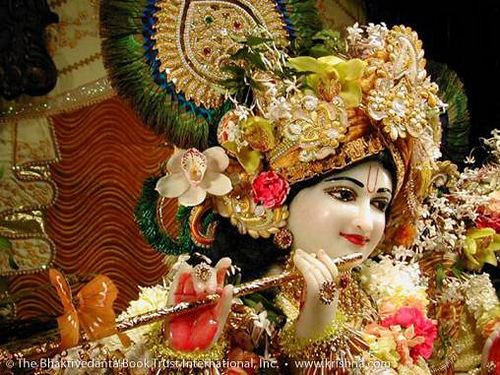
Description in the Harivamsa

Description
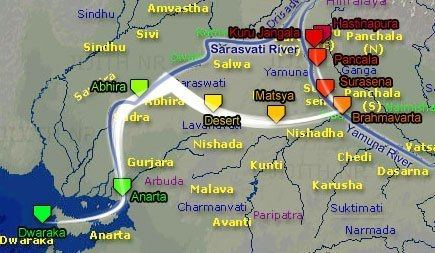
The following description of Dvaraka during Krishna’s presence there appears in the Srimad-Bhagavatam (10.69.1-12) in connection with the sage Narada’s visit.
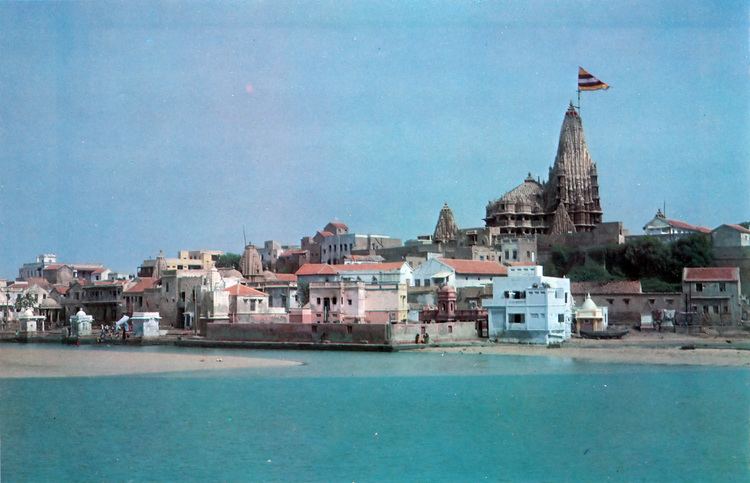
The City was filled with the sounds of birds and bees flying about the parks and pleasure gardens, while its lakes, crowded with blooming indivara, ambhoja, kahlara, kumuda, and utpala lotuses, resounded with the calls of swans and cranes.
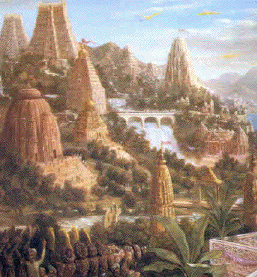
Dvaraka boasted 900,000 royal palaces, all constructed with crystal and silver and splendorously decorated with huge emeralds. Inside these palaces, the furnishings were bedecked with gold and jewels.
Traffic moved along a well laid-out system of boulevards, roads, intersections, and marketplaces, and many assembly houses and temples of demigods graced the charming city. The roads, courtyards, commercial streets, and residential patios were all sprinkled with water and shaded from the sun’s heat by banners waving from flagpoles.
In the city of Dvaraka was a beautiful private quarter worshiped by the planetary rulers. This district, where the demigod Vishvakarma had shown all his divine skill, was the residential area of Lord Hari [Krishna], and thus it was gorgeously decorated by the sixteen thousand palaces of Lord Krishna’s queens. Narada Muni entered one of these immense palaces.
Supporting the palace were coral pillars decoratively inlaid with vaidurya gems. Sapphires bedecked the walls, and the floors glowed with perpetual brilliance. In that palace Tvashta had arranged canopies with hanging strands of pearls; there were also seats and beds fashioned of ivory and precious jewels. In attendance were many well-dressed maidservants bearing lockets on their necks, and also armor-clad guards with turbans, fine uniforms, and jeweled earrings.
The glow of numerous jewel-studded lamps dispelled all darkness in the palace. My dear king, on the ornate ridges of the roof danced loudly crying peacocks, who saw the fragrant aguru incense escaping through the holes of the latticed windows and mistook it for a cloud.
Events
Archaeological findings
On May 19, 2001, India's science and technology minister Murli Manohar Joshi announced the finding of ruins in the Gulf of Khambhat. The ruins, known as the Gulf of Khambhat Cultural Complex (GKCC), are located on the seabed of a nine-kilometer stretch off the coast of Gujarat at a depth of about 40 m. The site was discovered by a team from the National Institute of Ocean Technology (NIOT) in December 2000 and investigated for six months with acoustic techniques.
A follow-up investigation was conducted by the same institute in November 2001, which included dredging to recover artifacts. Further underwater explorations were made in the Gulf of Khambhat site by the NIOT team from 2003 to 2004, and the samples, consisting of what was presumed to be pottery, were sent to laboratories in Oxford, UK and Hannover, Germany, as well as several institutions within India, to be dated. In a 2003 paper A.S. Gaur and Sundaresh of National Institute of Oceanography concluded: "The present excavation has thrown a light on the cultural sequence of Bet Dwarka Island. Around the 17th century B.C., late Harappan people had established their settlement, and they perhaps migrated from Nageshwar, which is close by. They have exploited marine resources such as fish and conch shells. It appears that Late Harappans of Bet Dwarka island had interaction with the Saurashtra Harappans and they might be visiting ports on the coast of the northern Saurashtra region. The scanty habitational deposit suggests that the site was abandoned after a couple of centuries. The island was again inhabited during the 8th century B.C. on the southeastern coast of the island."
However, inconclusive findings raised the possibility that the extremely old samples, as argued for many other artifacts recovered from the Gulf of Khambhat (Cambay), are not man-made artifacts or potsherds, but rather geofacts and related objects of natural origin. Michael Witzel argues that the "ruins" are either natural rock formations or the result of faulty remote sensing equipment and that the "artifacts" recovered are either geofacts or foreign objects introduced to the site by the very strong tidal currents in the Gulf of Cambay. The side scan sonar equipment, used to image the bottom of the Gulf, may have been faulty and the claimed supporting evidence is purely circumstantial.
One of the main controversies is a piece of wood that was carbon dated to around 7500 BCE, a date which is used in arguments for a very early date for a city here. Dr. D.P. Agrawal, chairman of the Paleoclimate Group and founder of Carbon-14 testing facilities in India, stated in an article in Frontline Magazine that the piece was dated twice, at separate laboratories. The NGRI in Hyderabad returned a date of 7190 BC and the BSIP in Hannover returned a date of 7545-7490 BC. Some archeologists, Agrawal in particular, contend that the discovery of an ancient piece of wood does not imply the discovery of an ancient civilization. Agrawal argues that the wood piece is a common find, given that 20,000 years ago the Arabian Sea was 100 meters lower than its current level and that the gradual sea level rise submerged entire forests.
